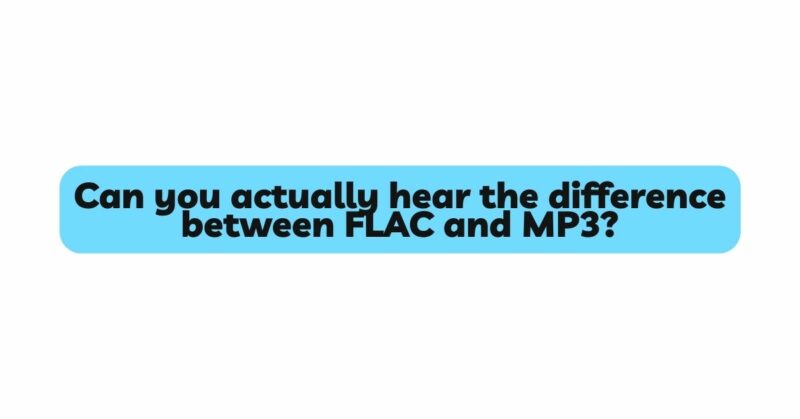In the ever-evolving landscape of digital audio, the debate surrounding FLAC (Free Lossless Audio Codec) and MP3 (MPEG Audio Layer III) remains an enduring enigma. At the heart of this discourse lies a fundamental question: Can you actually hear the difference between FLAC and MP3? This article embarks on a comprehensive exploration, traversing the technical intricacies, perceptual nuances, scientific experiments, and real-world implications that underpin this intriguing sonic conundrum.
The Essence of FLAC and MP3
Before delving into the auditory disparities, it’s essential to understand the essence of FLAC and MP3. FLAC employs lossless compression, meticulously preserving the full audio fidelity of the original recording. This makes it a favored choice for audiophiles and professionals who prioritize uncompromised sonic quality. MP3, in contrast, employs lossy compression, removing certain audio data to reduce file sizes while maintaining perceptible sound quality.
The Science of Perceptual Differences
The human auditory system is exquisitely attuned to subtle variations in sound. However, discerning the differences between FLAC and MP3 requires a keen ear, optimal listening conditions, and a deep understanding of audio nuances. Controlled listening tests have demonstrated that under controlled circumstances, trained listeners can identify subtle distinctions between the two formats. These distinctions often become more pronounced at lower bit rates and in complex musical passages.
Audiophiles and High-End Equipment
Audiophiles, armed with meticulously crafted audio systems, are often the torchbearers in the quest to identify differences between FLAC and MP3. Their sophisticated headphones, amplifiers, and acoustically treated listening environments enable them to perceive subtle variations that might elude the average listener. For them, the fidelity of FLAC stands out, and the differences may be vividly apparent.
Real-World Listening Environments
The allure of FLAC’s fidelity becomes more intricate when placed within the context of everyday listening environments. Consumer-grade headphones, portable audio devices, and ambient noise levels can influence the listener’s ability to discern subtle nuances. In such scenarios, the differences between FLAC and MP3 may become less perceptible, raising the question of whether the benefits of FLAC extend to practical, real-world settings.
Subjectivity and Expectation Bias
Human perception of audio quality is innately subjective, influenced by individual preferences and psychological biases. The phenomenon of expectation bias can significantly impact the perceived differences between FLAC and MP3. If listeners are primed to believe that FLAC is superior, they might unconsciously favor FLAC during listening tests, regardless of the actual auditory disparities.
Bit Rates and Quality Considerations
Bit rate is a critical factor in assessing audio quality. FLAC’s lossless nature allows for flexible bit rates, ensuring that no detail is sacrificed. On the other hand, MP3’s bit rates are often constant, with higher bit rates generally yielding better audio quality. It’s worth noting that recent advancements in audio compression algorithms have led to higher bit rate MP3 files that bridge the gap between FLAC and MP3.
Real-World Implications: Storage and Streaming
In the digital age, practical considerations such as storage and streaming cannot be overlooked. FLAC’s lossless compression results in larger file sizes compared to MP3, raising storage concerns for those with extensive music libraries. Streaming platforms, with their emphasis on efficient data transmission, often favor formats like MP3, which offer a compromise between quality and size.
The Art of Music Enjoyment
The question of whether you can actually hear the difference between FLAC and MP3 leads us to a broader contemplation on the art of music enjoyment. While discerning listeners might detect subtleties in FLAC’s audio fidelity, the average listener’s experience is influenced by convenience, portability, and the emotional connection to music rather than the minutiae of audio quality.
Conclusion: Navigating the Sonic Spectrum
The pursuit of unraveling the differences between FLAC and MP3 is a sonic journey that traverses technology, psychology, and individual perception. Audiophiles and enthusiasts with discerning ears can, under controlled conditions, uncover the distinctions. However, in everyday contexts, the audibility of these differences can be influenced by practical limitations and personal preferences.
The answer to whether you can actually hear the difference between FLAC and MP3 is a harmonious blend of objectivity and subjectivity. While FLAC’s fidelity remains unmatched for those who prioritize unadulterated sound quality, high-quality MP3 files have come a long way in bridging the gap. Ultimately, the choice between the two formats rests on the interplay of audio quality, storage concerns, streaming preferences, and the emotional resonance music holds in each listener’s heart.

